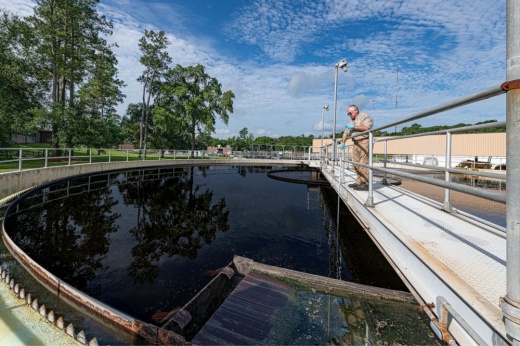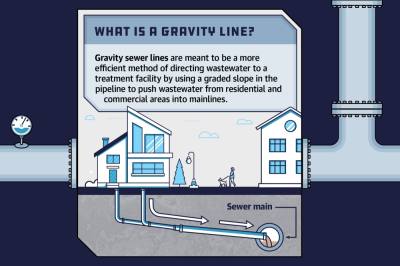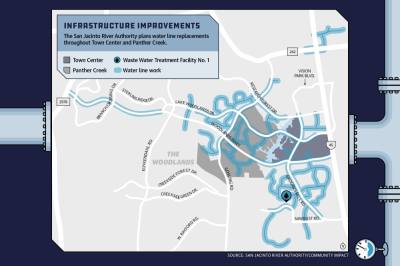The Woodlands turns 50 in 2024, and some of its infrastructure is also a half-century old or more. As part of the plan, the SJRA, which manages water resources in the San Jacinto basin, and The Woodlands Water Agency are proposing more than $374 million in projects to support the area’s water systems for the next 50 years.
Water- and sewer-related projects include a proposal for a new $226 million wastewater treatment facility on Sawdust Road as well as more than $62 million in plans to replace major water pipelines through Town Center and another $5 million to repair the Bear Branch dam.
"We deliver 95 million gallons per day of raw water to an industry on the east side of Houston,” said Connie Curtis, director of technical and operational services for the SJRA at the April 26 open house. “We’ve got 27 miles of canals that we actually manage and maintain. Some of that was from World War II, so we’re having to deal with infrastructure from the '40s on the east side of town.”
With several upcoming projects in The Woodlands area, the township and Woodlands Water Agency will play a role in messaging and preventing interruptions of service. The Woodlands Water Agency serves as the central management agency for 10 municipal utility districts in The Woodlands. However, SJRA officials said residents can expect to see higher sewer and water fees in future years as a result of the plan as the SJRA will likely seek revenue bonds for the projects.
New wastewater treatment facility
One of the biggest projects in the SJRA’s new 10-year capital project plan is replacement of The Woodlands Wastewater Treatment Facility No. 1 on Sawdust Road, which turns 50 this year. SJRA officials said the treatment facility project must be completed in the next 10 years to continue supporting community needs. The current overall water and wastewater infrastructure has reached end of life in a number of areas in The Woodlands according to the SJRA, which means numerous projects will be needed in the next 10 years.
Erich Peterson, general manager for The Woodlands Water Agency, said the wastewater project was approved to move into Phase 2 at the agency’s March 8 meeting.
The SJRA is evaluating the replacement of the wastewater treatment facility, and construction is expected to begin in 2027, Peterson said.
During Phase 1 of the project, the SJRA looked at alternatives such as consolidating the wastewater treatment plants on Research Forest Drive and in Harper’s Landing. The plan fell through after studies showed the Research Forest plant only has 20-25 years left in its service lifespan, said Daniel Hilderbrandt, technical services manager for SJRA.
Since the lifespan of wastewater treatment facilities is roughly 50 years, the Sawdust plant is at the end of its life Hilderbrandt said the SJRA determined it would be more efficient to construct a new facility.
“We don’t exactly know what that design contract would be looking like or how many packages it may potentially be,” Hilderbrandt said.
As part of the wastewater improvements, the SJRA is also looking at installing gravity lines, which are sewer lines installed at an angle in the ground that use gravity to move wastewater to the nearest treatment facility. This could allow some lift stations to be shut down and abandoned in favor of gravity lines. Lift stations are needed to push sewer from areas of low elevation to high. The proposed 10-year plan includes studies in lift station abandonment at Lift Station No. 1 on Woodlands Parkway.
The wastewater treatment facility will be funded through revenue bonds, but those will not be put up for public vote, Peterson said.
“The debt service on these bonds will be supported through revenue collected on the MUD retail water and sewer bills. This would be passed on to the customer most likely as an infrastructure renewal fee,” Peterson said in an email interview. There is no current estimate on what those fee increases could look like.
Meeting water needs
In addition to wastewater improvements, the township will require several main water pipeline renovations and dam upgrades, SJRA officials said.
The Bear Branch dam off Kuykendahl Road needs soil cement replacement, which is necessary to protect dams and dikes from upstream erosion, as well as a renovation of the spillway itself, Curtis said. The project is budgeted to begin in the third quarter of 2023 with a proposed budget of $5 million.
“We’re going to need some help making sure that we’re managing the community’s expectations and keeping the news out there,” Curtis said regarding future partnerships with agencies to keep residents updated.
Starting late 2024, work could begin on a number of pipeline replacements in Panther Creek and North Town Center. Budgeted at roughly $28.8 million and $22 million, respectively, the projects are set to begin design in late 2023 and will involve trenchless designs to minimize visual impact in the area, Curtis said. Trenchless designs involve making a few points of access to the pipelines and performing the rest of the repairs underground. Given the location of water lines requiring replacement, she said the visual and physical impact to residents would have to be a focus for engineers working the project.
SJRA Director of Operations Ed Shackelford said many of the water lines were built in the early 1970s and have been subject to a number of breaks and leaks over the last few years.
“We are seeing regular breaks of those lines, and they need to be replaced to extend the life of the infrastructure and maintain the reliability over the next 50 years,” he said.
Another upcoming project is the construction of a new water storage tank in the northwest portion of The Woodlands for $8 million for additional growth in the area affecting overall water pressure, Curtis said. Design for the project is expected to begin in the next three months with construction currently slated for third quarter of 2024.
Curtis told engineers and contractors at the open house that the sheer number of projects in The Woodlands area for the SJRA may require additional contracts to help move the bidding process along and break down the projects into manageable sections.
“If the projects go on a 10-year timeframe, SJRA is not staffed such that we can keep these projects moving; we’re going to need assistance,” she said. “Even if it’s a 15-year, we still may need help; even if it’s a 20-year, we still may decide we need help.”
Planning the impact
One of the main challenges of these projects is funding; Shackelford said the majority of projects will most likely be funded out of long-term debt. However, the SJRA is working on seeking funding from state and federal sources.
“We are looking at Texas Water Development Board funding, [and Water Infrastructure Finance and Innovation Act funding], but we are aware we may not qualify for many low-interest loans,” Shackelford said.
Shackelford said residents in The Woodlands should expect to see increases on their water and sewer fees at some point over the next several years as the projects are bid out and started. Since the majority of the projects scheduled over the next 10 years are in The Woodlands, residents in the area can expect to see the largest rate increase over the SJRA’s service area, he said.
Township officials are still awaiting more information from the SJRA regarding plans before communicating to residents, but officials plan to work with agencies to ensure residents are aware stay up to date on any service interruptions throughout the process.
“SJRA has been conducting public outreach regarding future water and wastewater needs, and we look forward to seeing what types of conclusions are reached,” said Nick Wolda, director of community relations for the township.
Shackelford said the project timeline may change or extend slightly over the next several years while the SJRA determines the funding mechanisms for the projects needed. However, the end-of-life status for many water lines and the wastewater treatment facility will require action sooner rather than later.








